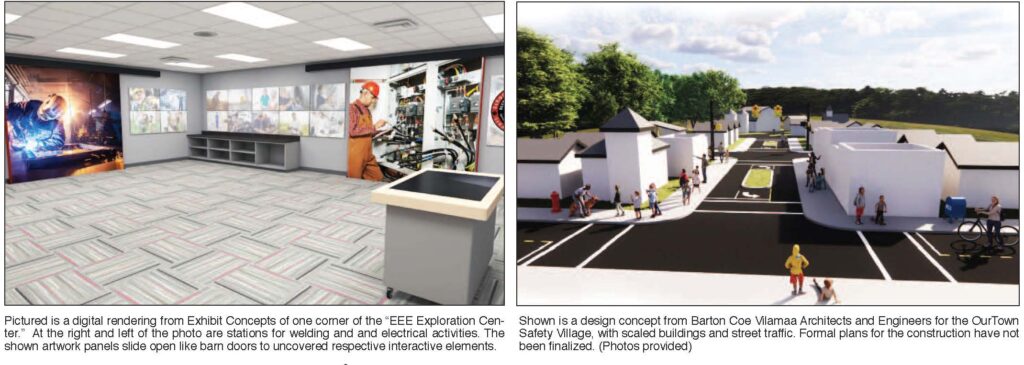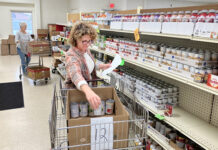Bluffton explores experiential learning opportunities
By HOLLY GASKILL
What if every school day was like a field trip?
While it may seem like a dream, Bluffton-Harrison schools are pursuing several opportunities that make this idea seem more of a reality.
The projects at hand are based in experiential learning, where students can learn concepts through doing a task or applicable experiences. In its ‘simplest’ sense, the preschool and middle school are incorporating themed classrooms to learn fundamentals and career pathways. At the largest scale, the district is endeavoring to build a playground version of downtown Bluffton.
The Preschool Farm Experience
The first of these endeavors is at the preschool, where a classroom has become a kid-sized farm, fit with silo and barn structures, farmers market toys, and wall artwork of sprawling fields.

Students review similar topics as they normally would but through a new realm of play and creativity. For example, students count as they round up toy horses in the barn and practice using money in playing at the cash register.
Elementary Principal Schlaura Linderwell first observed this kind of instruction at East Allen County preschool classrooms, where all nine classrooms had an immersive aspect ranging from a doctor’s office to a more abstract creative studio.
An experiential classroom, Linderwell said, also initiates conversations about career pathways. While the conversation matches the young understanding of the audience, she emphasized that it gets “the wheels turning” about their future and connection to the community.
“It really is a foundational piece that’s going to help kids,” Linderwell shared. “It’s a bit of a backward way of thinking. We think we’ve got to make sure they’re writing and reading, and they come to school, and they know all their letters — and we can accomplish that through play, inquiry, and exploration. It’s a much more developmentally appropriate way of learning.”
Administrators discussed concepts for a local application, and, ultimately, landed on a farm classroom given the agriculture community. Subsequently, they also found local partners who supported some of the costs, and whose names are now written on signposts on the wall artwork.

The project took over one year from concept to opening day this fall.
In practice, the five preschool classes will rotate into the experiential classroom for two weeks. During their rotation, students work through a curriculum developed by the BHES teachers specially for the classroom experience. This curriculum will be new every time a group rotates back into the classroom again.
“We’re extremely fortunate to have teachers and administrators who saw this vision and supported it,” Linderwell said.
The students’ excitement for the classroom is in no short supply. On the classroom’s opening day, the first rotation teacher and her students dressed as farmers.
As students gathered for instruction on a rug — which is supposed to look like a grass patch — in the opening week, students enthusiastically agreed when asked if they enjoyed the farm room. “I like that we get to make pretend money,” one student smiled shyly. “I just like it all so much!” another student chirped.
Long term, Linderwell hopes to incorporate experiential learning opportunities into several preschool classrooms. Discussions have begun regarding their next project, but Linderwell noted the school is a long way from getting started as they will have to restart the fundraising and design process.
Middle School Career Exploration
At the same time, the seventh and eighth grade will also be exploring their own version of an experiential classroom with the “EEE Exploration Center.”
The two grades complete a ‘college and careers’ class, where the students assess their skills and interests, possible career pathways, and general application and interview skills.
However, Assistant Superintendent Julie Meitzler said these lessons are often stymied by a lack of experience and understanding. Where a student is familiar with a classroom or doctor’s office, they may have no way to gauge a possible aptitude or interest for careers outside of their experience.
The class alone has proven valuable for students at a younger age. Eighth grade students can earn high school credit for the course, but feedback to Meitzler concluded the students wanted access to high school pathway information early in middle school. The one-semester course is now also being offered to seventh grade students.
This new classroom will also provide new interactive opportunities for students to explore several new pathways — food service, electrical work, and welding — all of which have coordinating technical classes in the high school. Meizler hopes that, by incorporating these items, more students will be able to identify their interest in high school technical classes before enrolling. The name of the classroom itself shows this relationship — in middle school, “EEE” stands for explore, engage, and experience, and in the high school, it stands for enroll, enlist, and employ.
“I think exposing kids to different career pathways in the exploration phase is just so important,” Meitzler said. “And I think seventh grade and eighth grade is a perfect spot to do that because they’re just starting to make some of those future choices.”
The project is currently in the design phase, but the school has acquired one interactive element — a virtual welder. The machine resembles an arcade game, allowing students to practice the fine motor skills and attention to detail used in welding materials.
Similarly to the farm experience classroom, the career exploration classroom will include top-to-bottom wall art and decor. “The goal is not to look like a classroom,” Meitzler said.
The school is working with Exhibit Concepts, based out of Ohio, for the design and construction. The group predominantly builds exhibits for museums and trade shows, so the classroom’s design will integrate instructional and museum space.
Exhibit Concepts will also develop interactive elements simulating food truck design for the culinary element, mock electrical circuits, and additional activities accessible by the students’ laptops. Much of this project has been made possible through a $200,000 grant from the Don Wood Foundation.
Construction will take place over winter break in December.
Our Town Safety Village
The last of current experiential learning endeavors for the district is the “Our Town Safety Village” at the elementary school. The 250-foot long by 130-foot wide outdoor area will serve as a scaled-down mock community to practice safety skills, like crossing a road and stranger awareness.
It’s a new idea to many but not to BHES. The kindergarteners take an annual field trip to Adams County Safety Park to introduce many safety ideas and skills. However, Superintendent Brad Yates believes it would be beneficial to have something to regularly review these ideas across the grade levels.
Having the home-field advantage, Yates explained, would also allow teachers to integrate the area into various lessons about safety and the community or simply provide a unique play opportunity. “This would be a continuous, ongoing opportunity for our elementary, not only from a safety element, but I think other things will blossom out of this,” Yates said. An annual trick-or-treating event is even held at a similar Fort Wayne site.
The safety village would also be the first of its kind in Wells County, allowing all three districts a closer opportunity to review safety skills.
Much about the Safety Village is still in its infancy. Ideally, the Safety Village would be able to resemble Bluffton, with buildings that mimic local resources, businesses, and industries. Preliminary designs for the project capture six key environments — a Bluffton residential area, downtown Bluffton, businesses, a rural home and farm, municipal services, and a church.
While the primary goal is to teach safety practices, Yates noted that these local connections again foster conversations about various careers and businesses, how the community works, and how to be an involved community member.
“A component of this area is when they’re out there, and they’re at a police station, or they’re at an automotive shop in the Safety Village, is to have those conversations and say, ‘This is where they work. These are the things they do,’” Yates explained.
Yates continued to connect this project to those being developed in the preschool and middle school with experiential classrooms.
“Things like these give what I like to call ‘spark moments,’ where (students) go, ‘I really like this’ and ‘I don’t like that at all’ … where they get the exposure. At the elementary, we just want them to have a little bit of knowledge and awareness that they’re more careers out there than the people they’re aware of. When I was little, I wanted to be a teacher or policeman or fireman because those were the jobs that people knew — they’re in the storybooks and on the TV show. To know what an auto mechanic was, unless your family member was one, you didn’t know. Those trade areas are prominent jobs in our community that are great jobs for people that live and work here, but it’s difficult to get exposure to kids.”
Ideally, Yates hopes work on the Safety Village will begin next spring. The district received only one bid thus far, which was unfortunately outside the district’s budget. Yates said the administration is currently evaluating how and when to rebid and the scale of the work.
Certain factors in the design, including electrical features and realism, also drive up the price. At its most elaborate, the area could appear as a one-for-one scale of local buildings and landmarks. Depending on funding, however, the district may opt for more generic shed-like structures with differentiating signage.
The district has received some state grant funding for the project and is in the process of determining the best course of action with the scope of the project, timing, and funding. The school may also pursue partnerships with local businesses to sponsor an Our Town building or an annual sign for the upkeep of the Safety Village.
Whatever the conclusion is, Yates confirmed, “We will do something.” He anticipates the Safety Village being built adjacent to the playground, leaving plenty of room for the sledding hill.
And, all together, the three projects project a vision for Bluffton schools — a connection between classroom and community.
Yates continued, “There is intentionality to try to provide that continuum — from a child’s experience at the kindergarten level all the way through the senior level — to see consistent opportunities, experiences, and education for the best we can provide.”
holly@news-banner.com



